



Featured image: @mothgenerator by Everest Pipkin and Loren Schmidt
Taina Bucher interviews artist and bot maker Everest Pipkin about their most popular Twitter bots, how they work and what they mean. Indeed, what are bots, who else is engaged in artistic bot-making, and how will social media bots evolve?
Meet Tiny Star Fields. Several times a day, the Twitter account publishes a field of stars in different shapes to a dedicated 51.000 followers. The latest tweet, published 53 minutes ago, has already been retweeted 151 times and gathered 114 favourites. Tiny Star Fields is a Twitter bot. During the last few years, bots, or automated pieces of software, have become an integral part of the Twitter platform. As some recent reports suggest, bots now generate as much as twenty-four per cent of posts on Twitter, yet we still know very little about who these bots are, what they do, or how we should attend to these bots. Admittedly, star-tweeting bots like Tiny do not belong to the kinds of bots that are most talked about. When people usually think of bots, they mostly have a specific type of bot in mind, which animates feelings of annoyance and disturbance. The spam bot, however, is but one kind of bot.
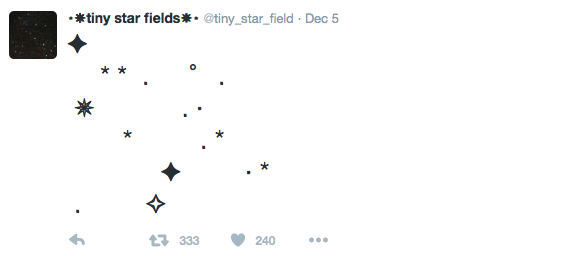
As Tiny and many others like to attest, bots are just like people. They are different. They tweet for different reasons, have specific audiences and engage with the world in various ways. Guided by their human programmers or taught to learn from existing data in playful ways, bots are legitimate users of platforms. But bots would be nothing without their creators, their makers who have conceptualized and brought these digital personas ‘to life’. So let’s not just meet Tiny Star Fields but also Everest Pipkin, the 24-year-old artist and creator of Tiny Star Fields.
Everest why don’t you tell us briefly about yourself and your background?
I grew up in the woods of Austin, Texas, where I also attended university for my undergraduate degree in studio art. Most of my work there was focused on drawing and installation, but I was also curating internet ephemera and beginning some rudimentary code projects at the time (albeit in isolation from others doing similar work). I also have a history in curation and have run creative spaces for many years. I’m currently pursuing my MFA at Carnegie Mellon in Pittsburgh.
What got you started with making Twitter bots?
I started making bots in the summer of 2014. I moved to a tiny town in rural Minnesota (population 900) for a longer-term artist residency and was quite isolated. I didn’t have a car, there was no bus or train, and I didn’t know anyone there. I was used to being alone on residency, but often I had friends near enough to visit or a local coffee shop to haunt. With no other options, I was at home and online almost constantly. The internet has always been important to my practice (and my social life), but I attached myself to it as a lifeline in that period.
I was already following Twitter bots (@everycolorbot, @youarecarrying, @twoheadlines, @minecraftsigns, @oliviataters, @prince_stolas, and I’m sure many others), but being online constantly shifted how I thought of them, rather than just seeing their occasional statements as charming non-sequiturs in a human space, I started to notice their underlying personalities, the structure of code that differentiated one from another; when they posted, the kind of source materials used, how they interacted with others. With nobody to keep up with locally, I also began sleeping in erratic structures- some nights for 5 hours, others for 14. As a side effect, I would catch off times on Twitter, where everyone but the bots were asleep. These timelines of automation had a striking effect. I was particularly fond of the bot chorus around the turn of the hour- bot ‘o clock, as some call it.
I had been following and aware of @negatendo’s #BOTALLY posts (a sort of # organizing structure for bot-related news and resources) for a while, but I also started following @thricedotted, @inky, @beaugunderson, @tullyhansen, @aparrish, @boodooperson and @tinysubversions (and many others!) in this period. There were new bots almost every day, all unique, and I was really taken by how people interacted with them and how they operated in that social space.
How did you go about making your first bot?
I got node.js set up on my laptop (no small task for me then) and figured out some fundamentals of text manipulation in javascript. After several false starts, I made my first bot, @feelings.js, in the afternoon. I made @tiny_star_field five days later, in the middle of the night, hiding in my basement during a tornado. The power was out, and I’m almost certain I got the structure done in one laptop charge. I deployed it when the power and internet came back the next day.
You waited for the sky to clear and become sprinkled with stars again. In the meantime, you made your own digital sky, that’s cool. Did you do a lot of programming before starting with making bots?
I suppose that depends on what you mean by programming. I had worked in and around browser-based experiences for years but had never taken a structural approach to learning code. Every new idea and project had a particular set of problems that I attacked with utter naivete, writing vast messes that were shocking when they worked. Looking at my source code for those projects now is very much like looking at an outsider-art approach to computer science. Which is, I suppose, what they are.
I still sometimes struggle with basic concepts just because I haven’t run into them before- I learn best when directed at a goal, and sometimes those goals skirt fundamental structures. My knowledge is a funny hodge-podge assemblage of extremely difficult concepts I needed for some project or another, while I may forget the syntax for a basic sentiment. I keep telling myself I’ll read a book or take a course on putting code together properly, but so far I keep learning what I need. I am sure I will feel the same about my current projects in a year or two as I do about my older ones. My first bots are very embarrassing inside and it has only been a year and change.

You’ve said that @tiny_star_field is your most popular bot, but your personal favourite is @feelings_js. Would you care to elaborate?
Neither of those bots came from a particularly well-considered place technically; they were the first I made, and I was learning. I was tickled by the idea of a bot that did nothing but emote; it seemed like a charming inversion of the coldness that often creeps into automata. Tiny was a simple reflection of my Unicode character habit; I have a hobby of making little vignettes or dioramas combining characters and atypical symbols, and I have been enjoying automating them. (I am also now a Unicode Consortium member and am working structurally with these characters.)
That comment about favourites was from a long while back, and my favourite bot is probably now Moth Generator (@mothgenerator), which was a collaboration with @lorenschmidt. It’s different from many of my bots; it’s just a wrapper on an image generator, but it is the first bot I’ve made that I felt used @-replies in a truly useful manner. It takes the text of the tweet sent to it to seed the generator with a unique number; therefore, the ‘moth’ moth will always look like every other ‘moth’ moth, while a ‘bot’ moth would shift in many ways. A ‘moth bot’ moth would share characteristics of both.
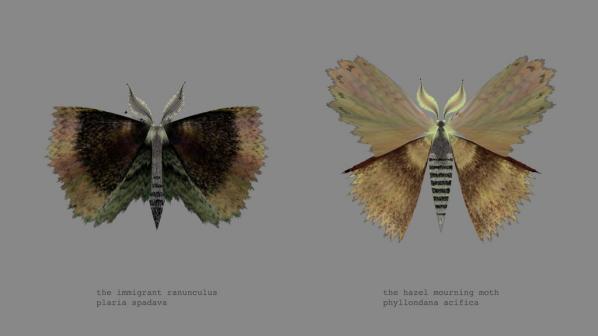
How do these bots work?
Feelings.js (and a few others like it) is basically a fill-in-the-blank Wordnik wrapper. It has a variety of possible sentence structures on a switch statement and then pulls parts of speech from the dictionary API. I have a few structural rules that slightly favour alliteration and a few other cute tendencies (blocking offensive words), but it is basically mad-libs.
Tiny is even simpler; it has a large array of star and space options and pulls randomly from the available options. The biggest challenge was finding an ideal balance between character frequencies. I tweak it occasionally and don’t feel it is ideal yet. I am tempted to make it sparser. I am also in the process of making a Tiny Star Fields clone that uses actual astronomical data at varying scales, so the tweets will be a literal patch of sky.
Some of my other bots are a little bit more complicated- Moth Generator is a wildly long drawing routine in Javascript, Sea Change (@100yearsrising), tweets unicode characters mapped to sea-level rise predictions over the next century. Others use more obscure text manipulation techniques and large corpuses. But I think it is important to note for folks just starting that complication does not necessarily make them stronger artistically or more popular socially- the best things are almost always just good ideas.

What has been the response to your bots?
There is certainly an audience of bot appreciators; sometimes, I will see people who follow 30 or 40 bots but none of their makers. Bots also have their own secret lives outside of intention. Tiny auto-followed people back for a while (something like the first 6k) made for a truly wonderful sample! Very few are in the bot community; I think the vast majority are One Direction fans. It is a fascinating slice of social life I would never think to seek out myself.
What is the bot community that you are referring to?
Gosh, what is the bot community, good question. I suppose it seems to be a loosely associated group of folks interested in social bots. People seem to come from all walks- programmers, game developers, linguists, writers, artists, analysts, and poets. Making the skeleton of a Twitter bot is a fairly simple exercise and doesn’t inherently have the high knowledge overhead of some other creative programming tasks. They are also incredibly flexible in content and process, and I think that mutability allows a certain wealth of intent from bot to bot. These two avenues of openness mean they are used for all sorts of things! As entities, they are as unique as the people who make them.

In general, I’ve found folks who are organized around making bots to be nothing but supportive, kind and interested in helping others get started with producing their own work in this realm. Within that community, structure are also all the folks that might not make bots (yet) but know what they are, and are interested in their processes, or write about them, or consider them valid as artworks or creative entities.
What, indeed, are bots?
What are bots? Gosh, this is an even better question than the one about bot communities. So, there are many ways to think about bots, and in my opinion, they are stackable and do not refute one another. But here are my thoughts:
Firstly, they aren’t new automata has been around for a very, very long time. One can look at examples of clockwork machines or candle-powered toys from over 1000 years ago. Even beyond physical examples of automata, the idea of bots is pervasive culturally; stories about golems and enchanted armour or physical objects imbued with personality have been with us since stories began.
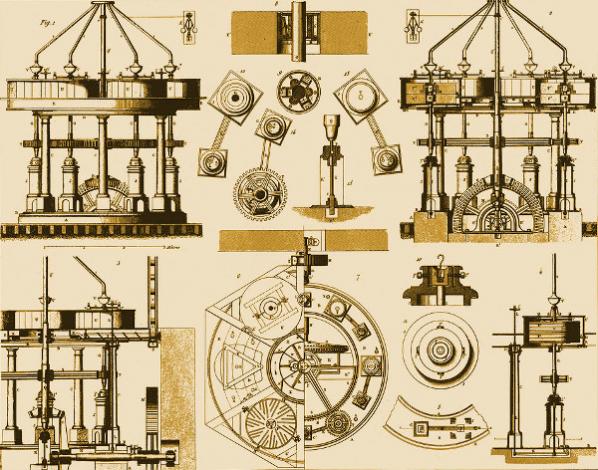
Digital bots (especially those living in social spaces) fit into this long history of objects granted almost humanness. They fill in for a part of human action, the slice of person granted to digital representations of ourselves. Just like the golem that guards a passage, their tasks are programmed, but we grant them entity because they do these tasks on their own (guard, tweet). Perhaps this is as much doubt (“Is it /really/ a bot, though? Maybe it’s just a person pretending?”) as it is a gift.
Secondly, I do think there is an aspect of doubling or mirroring that these bots employ. They are widening the reach of their creators; they are automated versions of a specific slice of their creators. Many, many bots fall into this category. Something Darius Kazemi once said first got me thinking this way. It was advice to a want-to-be bot maker who didn’t have an idea for a bot. Darius suggested ‘come up with a funny but formulaic joke and automate it’. This type of repetitive production is not just seen in joke bots but almost all bots that are not attempting to emulate humanness. The maker would have made the joke once; by making a bot, it is made many times (but also, perhaps made better than it would have been once).
To expand, the goal of work-by-generation is a fundamentally similar but shifted process from that of work-by-hand; rather than identifying and chasing the qualities of a singular desired artwork, one instead defines ranges of interesting permutations, their interpersonal interactions and how one ruleset speaks to another. Here, the cartographer draws the cliffs that contain a sea of one hundred thousand artworks. And then, one searches for the most beautiful piece of coral inside of their waters.
So, I suppose this is where bots are truly interesting to me because this kind of making (looking for the best moment in a sea of automated possibilities) is a methodology of construction that feels, in some ways, new.
I like the notion of bots leading secret lives. Are you ever not in control over your bots? Or what does this secrecy entail?
I take a pretty lax approach to keeping up with my bots. I rarely log into their accounts or closely monitor what they are up to. I censor certain offensive words, follow them on my Twitter account, and hope to catch them if they break. This means that their notifications never reach me; the things that are said to them (or their own replies) are often invisible to everyone but them.
In what ways do people or other bots interact with your bots?
Most (although not all) of my bots are non-interactive, meaning they do not @reply back when spoken to. That being said, they are absolutely interacted with. Tiny star fields, in particular, get a ton of messages; lots of people will have conversations in the mentions. I find them pretty charming and will occasionally peek at what people are saying to one another. Since I generally keep @replies off, I don’t get the bot-to-bot eternity loops you’ll sometimes see with the image bots, ebooks bots, or others that reply. But I always like it when spam bots or Reddit bots find mine by keyword search. The best example of designed bot interaction might be Eli Brody’s tiny astronaut (https://twitter.com/tiny_astro_naut), which inserts spaceship emoji into Tiny star fields’ tweets, or its conceptual sibling, tiny space poo (https://twitter.com/tiny_space_poo).
How many of your bot’s followers do you reckon are other bots, and is bot-to-bot interaction different to how humans interact with bots?
I haven’t done the numbers, but it seems like there is a slightly higher percentage of bot-to-bot followers than human-to-bot. I would guess this combines auto-following routines and being manually directed to follow entire lists of other bots. Perhaps also, they are more patient with repetitive or nonsensical tweets and stick around longer.
Most bots now have conversational abandonment built in, but this was not always the case- it was once pretty common to see two replying bots get into a conversation with one another that would last hours or days, to the tune of thousands of tweets, one every few seconds. I once got accidentally caught in mentioning one of these cycles and had to wait for one of the bot’s owners to wake up and reset their servers. It was amazing, and I also had to turn off all notifications on every device I own.
Now, I think most bots use more intelligent replying- just to one person, randomly across their followers, or only every 10 hours, or perhaps replying to keywords or requests. To me, this has made bot-to-bot interactions feel a lot more human.

Do people ever wonder about you, the human behind the bot?
Many people who follow Tiny Star Fields do not understand that it is a bot! Or that bots are even on Twitter. The predominant interaction that seems to occur runs along the lines of “DO YOU SLEEP” or “what is this” or “I love these thank you so much for making them all the time”. I find that disconnect pretty delightful- the assumption of a (very) dedicated human somewhere. I’m also fond of the interpersonal conversations in the comments, often having nothing to do with the original stars; it occasionally functions as a bit of a forum for strangers to connect.
Where do you see Twitter bots or social media bots generally evolving?
I have found myself moving off of Twitter and back into non-social spaces for much of my work. Part of this is probably personal; my interests shift project-to-project. Part of it is intrinsic limitations in the media, the 140-character limit, and the difficulty of keeping up with Twitter’s often evolving terms of service. I am interested in physical robots or the housing of digital spaces- where these bots live- and a lot of my studio practice is now exploring tangible machines. Some of the best bots I’m seeing out of others use neural nets or very clever source material. In my own work, I am looking forward to more physical-digital integration, especially as I pick up some new toolsets required for more complicated work. I am interested in biological emulation and the hidden data that Twitter links to every tweet (perhaps my next bot will not be readable on the Twitter web client but instead comes alive in an API call?).
A small part of me also feels like others have taken up the call (and doing it better than I ever could have). This is to say, Twitter bots are in a kind of renaissance- tools like George Buckenham’s Cheap Bots Done Quick (which uses Kate Compton’s Tracery) and the plethora of tutorials and frameworks have radically democratized the process, and it seems like every day I see someone new to this space building interesting or beautiful things. I am learning as much from newcomers to the form as anything!
In short, for the future- who knows? But now, bots are serving as a fascinating space to test new ideas, construct entities and artwork of generated text and data, and publish those experiments to an audience excited to see them in the world. What more could one hope for?
Finally, what are your favourite bots at the moment?
https://twitter.com/CreatureList – automata bestiary from @samteebee
https://twitter.com/FFD8FFDB – image-processed security cameras by @derekarnold
https://twitter.com/imgconvos – a @thricedotted answer to image-bot loops
https://twitter.com/everycolorbot – The first bot truly dear to me still going strong, thanks to @vogon
https://twitter.com/reverseocr – a @tinysubversions bot that randomly draws until it hits whatever word it is trying to match in an OCR library
https://twitter.com/ARealRiver – the only real way to view this (very clever) bot is in its own timeline, probably on mobile. from @muffinista
https://twitter.com/LSystemBot – l systems by @objelisks
https://twitter.com/INTERESTING_JPG – a bot-form of deep learning, which attempts to describe human images with computer vision, by @cmyr
https://twitter.com/park_your_car – compelling use of google maps highlighting available car space by @elibrody
https://twitter.com/wikishoutouts – shoutouts to the disambiguation pages of Wikipedia
https://twitter.com/soft_focuses – a very quiet mysterious bot from @thricedotted
https://twitter.com/TVCommentBot – attempted image recognition of television, @DavidLublin
https://twitter.com/GenerateACat – procedural cats – @mousefountain and @bzgeb
https://twitter.com/pentametron – a bot that looks for tweets in accidental iambic pentameter by @ranjit
https://twitter.com/RestroomGender – @lichlike’s gendered restroom sign generator
https://twitter.com/digital_henge – This bot by @alicemazzy tweets moon phases, eclipses, and other solar and lunar phenomena
https://twitter.com/a_lovely_cloud – digital cloud watching from @rainshapes
https://twitter.com/the_ephemerides – computer-generated poetry with outer space probe imagery, @aparrish
To find out more about Everest Pipkin’s latest projects, please visit Everest Pipkin
Richard Stallman[1] the outspoken promoter for the Free Software movement, hates Facebook with a passion. He proposes that we should all leave Facebook and either find or build our own alternatives. The evidence offered by Stallman’s and the Electronic Frontier Foundation’s (EFF), who have been fighting for Internet freedoms since the 90s [2] shows how necessary it is that we understand and are more pro-active in managing the personal data that we give away through our online activities.
When we subscribe to Web 2.0 platforms such as Facebook we are at the mercy of the data brokers. These companies trade in people’s personal data; information which is aggregated by monitoring user actions and interactions across social media. This information can include “names, addresses, phone numbers, details of shopping habits, and personal data such as whether someone owns cats or is divorced.”[3] Fast moving developments in social media, make it difficult to keep up with the effects and consequences of these platforms. This is why the work of groups such as Commodify Inc. is so valuable. They bring imaginative and critical attention to the situation, sharing their knowledge of these daily networked complexities and correcting what they see as its negative effects.
Commodify Inc. is an artist-run Internet startup producing projects to help individuals capitalize on their online monetary potential. Their intention is to correct the imbalance of power in markets where users have no control over the transactions made with their personal data. They have completed various artistic projects and interventions on social media like, Fame Game, Give Me My Data, and Web 2.0 Suicide Machine. The co-founders are Birgit Bachler, Walter Langelaar, Owen Mundy, Tim Schwartz, with additional contributors Joelle Dietrick and Steven Alvarado.
Their new project Commodify.Us, was initiated when Owen Mundy and Tim Schwartz were invited by moddr_ to a residency in their lab in the summer of 2012 – when they were still a part of the WORM collective in Rotterdam. They worked on an initial idea that would succeed previous experiences of their already well-known and respected projects.
Commodify.Us is currently in beta phase. It promises to provide a platform for people to regain control over the commercial exploitation of their own personal data.
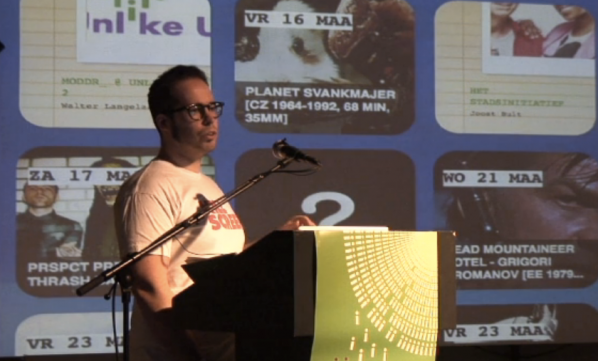
Intrigued by this project I contacted one of the co-founders, Walter Langelaar via email and asked him a few questions about this new platform.
Marc Garrett: Commodify.Us is for people to have greater control over their data. And it works when users export their data from social media websites and upload it to your platform. How will these users gain more control over their data and why is this important?
Walter Langelaar: Commodify.Us provides a platform for you to regain control over the commercial exploitation of your personal data. After exporting your profile data from social media websites and uploading the data to Commodify.Us, you can directly get in contact with interested buyers. On the importance for users I would say that it’s part raising awareness surrounding the monetization of profile data, and part creating a platform where people might work out and discuss how to do this themselves.
MG: It proposes to re-imagine the potential of relational data, creating a casting agency for virtual personas. I’m wondering what this may look like?
WL: We were too. In an early stage of the project we played with the idea that peoples’ various profiles could function like that within an agency; a client would ask for a specific set of qualities and/or characteristics within a set of profiles, and we could provide for this based on the uploads and their licensing options as set by the user. In the end we abandoned this idea for clarity.
MG: Commodify.Us offers people the opportunity to be part of an economy where interested buyers will pay to use the data supplied, unlike existing social media websites. How does this work?
WL: We are gearing up for a launch where the main goal will be to get a critical mass of around, a 1000 profiles. We anticipate that only with this kind of mass or volume will our initiative take hold with the potential buyers we have in mind, and the same goes for the more creative projects that could use the (open) data. Regarding the open profile data and otherwise licensed profiles that allow for reuse, we are researching the idea of ‘Fair Data’ (as in Fair Trade) and how to implement this as a profitable protocol for the end-user.

“Net activists construct tools whose intervention potential can be initiated by users under net conditions. These tools enable activists to develop new strategies in the data space of the Internet because they offer new means: New means afford new ends.”[4] (Dreher)
In his publication Networks Without a Cause: A Critique of Social Media, Geert Lovink lays down the gauntlet and asks us to “collectively unleash our critical capacities to influence technology design and workspaces, otherwise we will disappear into the cloud.” Anna Munster opens her excellent survey, Data Undermining: The Work of Networked Art in an Age of Imperceptibility, by saying “The more data multiplies both quantitatively and qualitatively, the more it requires something more than just visualisation. It also needs to be managed, regulated and interpreted into patterns that are comprehensible to humans.”[5] Commodify.Us goes one step further by allowing users to manage, regulate, repattern and reappropriate their own data using tools that share an essential functionality (if not purpose) with the power tools of Web 2.0.
Those previously seen as rebellious hacktivists are moving into new territories that deal with concepts of service. There has been a significant rise of artists exploring technology to influence mass Internet activity, against the domination of corporations who are data mining and tracking our on-line activities. Another example is TrackMeNot developed by Daniel Howe and Helen Nissenbaum. This is an extension created for the Firefox browser. “It hides users’ actual search trails in a cloud of ‘ghost’ queries, significantly increasing the difficulty of aggregating such data into accurate or identifying user profiles.”[6]
Howe and Nissenbaum mention they are aware their venture is not an immediate solution. However, the more we hear of and join these imaginative strategies “whereby individuals resist surveillance by taking advantage of blind spots inherent in large-scale systems” [7], and the more we adapt our behaviours to adopt these new ‘activist’ services, the more we demonstrate the demand for these new alternatives. And by so doing, we argue for the value of services that we can trust not to steal or manipulate our social contexts for financial and political gain.

A significant value offered by the Commodify.Us platform is the power to manage our own data. The simple act of downloading our own data from Facebook, and then uploading it to Commodify.Us supports us to rethink what all this information is. What once was just abstract data suddenly becomes material that we can manipulate. Alongside this realization arrives the understanding that this material was made by our interactions with all these platforms, and that other people are spying on us and making money out of it all. Once this data material is uploaded onto the Commodify.Us platform, it asks if we want this stuff to be a product under our own terms, or if we wish to make art out of it using their tools.
This is a cultural shift that demonstrates how contemporary Hacktivists are developing software that promises to offer realistic service infrastrucutures. When I interviewed Charlie Gere in 2012[8] he said that these artists “are not part of the restricted economy of exchange, profit, and return that is at the heart of capitalism, and to which everything else ends up being subordinated and subsumed. Thus they find an enclave away from total subsumption not outside of the market, but at its technical core.” For me, this kind of work is of central importance to the contemporary era, and it only occurs where artists cross over into territories where their knowledge of networks directly contributes to the building of alternative structures of social independence.
Charlie Gere is a Media Theory and History professor in the Lancaster Institute for Contemporary Arts, Lancaster University. Co-curator of FutureEverybody, the 2012 FutureEverything exhibition in Manchester. In 2007 he co-curated Feedback, a major exhibition on art responsive to instructions, input, or its environment, in Gijon, Northern Spain. He has given talks at many major arts institutions, including the Centre de Cultura Contemporània de Barcelona, the Architectural League in New York, Tate Britain, and Tate Modern. Gere’s new book, Community without Community in Digital Culture (Palgrave MacMillan, 2012), is out now.
Previous titles include: Digital Culture (Reaktion Books, 2002), Art, Time and Technology (Berg, 2006), Non-relational Aesthetics, with Michael Corris (Artwords, 2009). Gere was co-editor of White Heat Cold Logic (MIT Press, 2009), and Art Practice in a Digital Culture (Ashgate, 2010), as well as writing many papers on questions of technology, media and art. He is also co-editing with Robin Boast an anthology entitled Allegories of the Information Age (forthcoming).
Marc Garrett: Digital Culture was originally published in 2002, which happens to be the version I’ve had all these years. In 2008 it was republished, revised and expanded. Now the book has an extra chapter ‘Digital Culture in the Twenty-first Century’. Of course, we already know that digital technology and society has changed dramatically since 2002. So, what themes and historical contexts did you choose, as necessary to include in this new and last chapter?
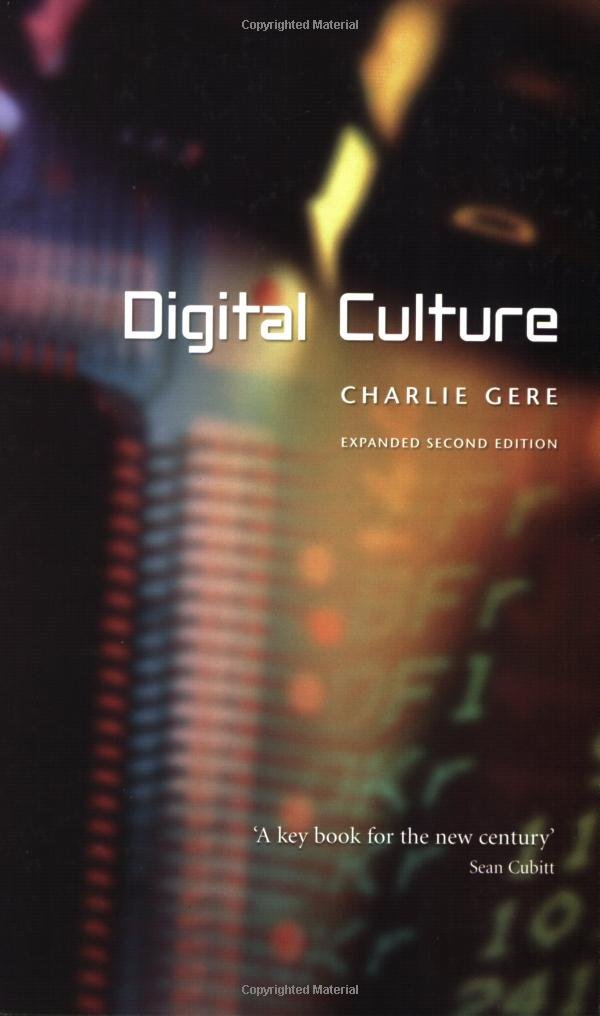
Charlie Gere: What happened after the first edition’s publication was of course, the rise of so-called Web 2:0, which was simply the greater exploitation of the reciprocal possibilities of the Web. I tried to reflect on how this reciprocity was visible beyond the Web itself and was becoming part of a more general culture of engagement and exchange, not that I share some of the more utopian visions of this phenomenon. Indeed, in my new book Community without Community in Digital Culture, I try to counter the, for me, more naive visions of community in relation to digital technology. I advocate a more ‘non-relational’ approach that does not deny the transformative effects of new media in terms of community but thinks of it more in terms of hospitality to the other.
MG: Many of the artists we have worked with are using new media to explore and critique the utopian assumptions you discuss: YOHA, IOCOSE, Liz Sterry, M.I.G (Men In Grey, Julian Oliver and Danja Vasiliev), Heath Bunting, Face to facebook (Paolo Cirio and Alessandro Ludovico), Annie Abrahams and more. Each of them work in a deeply relational way to intervene in the mythologies projected about digital technology; and, with a knowingly crtical eye of the technical limitations and the social controls at work when using networked technology. At different levels, all are producing work that ‘consciously’ incoporate relational contexts, in some way or another, this includes ideas and approaches with autonomy as part of their art, but not necessarily advocating technology as a singular, saving grace.
How do you view the role of this practice in the context of the wider corporate and state impact on the way technical cultures are evolving. How do you see the notion of hospitality working between the arts and these other more mainstream cultures?
CG: I greatly admire and like the work of the artists you mention and others doing similar things. For me they exemplify the complexity of the idea of hospitality. In general the Web is about exchange, whether that of money for goods, social links and relational exchanges in social networks, or the exchange of speech and dialogue in on-line fora. The work of these artists refuses this demand for exchange and profit within a restricted economy. Thus they are in a sense parasitical on the Web. The word ‘parasite’ comes from ‘para sitos’, meaning ‘beside the grain’, and refers to those animals that take advantage of grain stores to feed. They are the creatures to who must be offered hospitality, as a gift, without expectation of return, which means that while they are bound up with the technological systems that comprise the Web, they are not part of the restricted economy of exchange, profit, and return that is at the heart of capitalism, and to which everything else ends up being subordinated and subsumed. Thus they find an enclave away from total subsumption not outside of the market, but at its technical core.
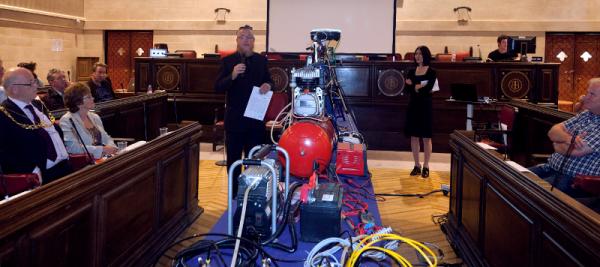

MG: Many are aware that technology and digital culture have changed the world we live in and appreciate their immediate effects on our everyday behaviours and situations. But there is a bigger story to tell, and history can offer us insightful glimpses, important clues and ways into this story about our relationship with technology and digital culture. One of the arguments outlined in your book ‘Digital Culture’ is that digital culture is neither radical, new nor technologically driven. With this in mind, which past developments do we need to acknowledge and be reminded of and why?
CG: For me the emergence of digital technology is part of a much longer story of abstraction, codification, quantification and mathematisation that can be traced back to numerous points in the history of the West, from Ancient Greece, to early Modernity to the rise of industrial capitalism. Here one might think of Heidegger’s use of ‘cybernetics’, a word we normally associate with post-war computing culture, to describe the technology and calculative enframing of modern society which he traces back to the Ancient Greeks and especially to Plato. I am not a particular advocate of digital technology, and while I appreciate its uses, I also think we must try to be aware of how it determines the way in which we think, and in which we conceive of the world. Above all we should not regard it as merely a conduit to an uncomplicated world simply out there, but rather the means by which a particular world comes to be for us. That said, this is very hard, given that in my view, and to adapt a well-known phrase from Derrida, il n’y a pas de hors-media, there’s no Archimedean point outside of our medial condition, from which we can understand it as from a god’s eye view. ‘Media determine our situation’ as Friedrich Kittler put it.
MG: In Digital Culture, you write about the composer John Cage and how he “has had the most profound influence on our digital culture”, and how his influence has opened up various different avenues of creative engagement. And, many of his ideas on interactivity and multi-media not only “have repercussions in the art world”, but also a strong influence on how computers are used as a medium. Which art movements in particular did he influence and what kind of legacy did he leave for others in relation to computers?
CG: Actually Cage’s influence on those using computers in the arts is probably less to do with what he himself did with such technology and more to do with his use of aleatory methods in many his different projects across many artforms. Also there is something about Cage’s own refusal of a normative Western subjectivity that is also consonant with aspects of our hyper-technologised existence with its emphasis on decentering the individual. Both the refusal of such subjectivity and the aleatory work together to produce a new model of the artist as conduit of contingent social forces rather than protean demi-urge or genius.
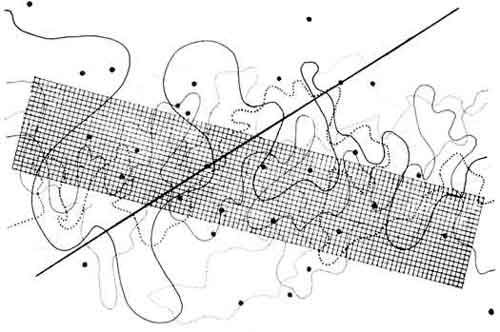
MG: Your new book ‘Community without Community in Digital Culture’, has come out at the same time as Geert Lovink’s ‘Networks Without A Cause: A critique of Social Media’. Lovink asks “How do we overcome this paradoxical era of hyped-up individualization that results precisely in the algorithmic outsourcing of the self? How do we determine significance outside of the celebrity paradigm and instead use intelligence to identify what’s at stake?” [1]
Where are your thoughts in regard to Lovink’s question, and does it relate to what you propose in terms of “hospitality to the other?”
CG: I haven’t read Geert’s book, yet at least… But I am highly sympathetic to what I take to be his position. My view is that the Web is part of a broader set of developments that apparently concern relationally, but actually emphasize the sovereign individual and autonomous subject of modernity, as well as promoting spectacular and image-bound forms of presentation and relation. The problem is that one alternative to this individualization is a kind of fascistic identification with the mass, in the form of fusion that negates the individual. A solution maybe to engage with the idea of the other in terms of difference, as both relational and separate, and yet also that which we depend on for our identity in a process of differentiation; thus the idea of hospitality as a reception of the other in difference.
MG: Community without Community in Digital Culture, is a curious title. It proposes contradictory meanings and these contradictions are clearly explained in the introduction. Although, the last sentence says “In this such technologies are part of the history of the death of God, the loss of an overarching metaphysical framework which would bind us together in some form of relation or communion. This can be understood in terms of contingency, which has the same root as contact.”
Could you unpack this last sentence for us, I’m especially interested in what contingency means to you?
CG: I owe my understanding of contingency to the work of philosopher Quentin Meillassoux, whose book After Finitude is causing a stir. Meillassoux is one of a small number of young philosophers sometimes grouped together under the name ‘speculative realism’, mostly because of their shared hostility to what they call ‘Kantian correlationism’, the idea that there can be no subject-independent knowledge of objects. Meillassoux follows the work of David Hume, who questioned the whole notion of causation; how one can demonstrate that, all things being equal, one thing will also cause another. For Hume causation is a question of inductive reasoning, in that we can posit causation on the grounds of previous experience. Meillassoux pushes the implications of Hume’s critique of causation to a point beyond Hume’s own solution, to propose the only necessity is that of contingency, and that everything could be otherwise, or what Meillassoux calls ‘hyperchaos’.
![Community without Community in Digital Culture [Hardcover]. Dr Charlie Gere. Palgrave Macmillan (2012) http://www.barnesandnoble.com/w/community-without-community-in-digital-culture-charlie-gere/1110025572 See on Amazon.](http://www.furtherfield.org/wp-content/uploads/2012/09/179510500.jpg)
I use his ideas to think through the implications of the ‘digital’. According to the Oxford English Dictionary ‘digital’ has a number of meanings, including ‘[O]f, pertaining to, using or being a digit’, meaning one of the ‘ten Arabic numerals from 0 to 9, especially when part of a number’, and also ‘designating a computer which operates on date in the form of digits or similar discrete data… Designating or pertaining to a recording in which the original signal is represented by the spacing between pulses rather than by a wave, to make it less susceptible to degradation’ (the word for data in the form of a wave being ‘analog’).
As well as referring to discrete data the dictionary also defines ‘digital’ as ‘[O]f or pertaining to a finger or fingers’ and [R]esembling a finger or the hollow impression made by one’, thus by extension the hand, grasping, touching and so on. Much of the book concerns deconstructing the ‘haptocentric’ implications of contact, and communication, especially in relation to the claims made for social networks, and to engage with what I understand as the relation between ‘contact’ and contingency’. ‘Contingency’ is derived from the Latin con + tangere, to touch. ‘Contingency’ enables us think through the implications of the term digital, by acknowledging both its relation to the hand and touch and also to the openness and blindness to the future that is a concomitant part of our digital culture after the death of God.
MG: What other subjects can we expect to read about in the publication?
CG: Touch in Aristotle and medieval theology, cave painting, mail art, Darwin and Dawkins, Luther Blissett, On Kawara, Frank Stella, Bartleby the Scrivener, Christianity – among other things… oh, and a lot of Derrida.
MG: If there is a message you’d like to send to the world, as it carries on regardless with its “permanent exposure of life, of all lives, to ‘all-out’ control […] thanks to computer technology” [2] (Virilio 2000), and it was printed on a banner, or on a billboard in the streets, what would it be?
I am reading Blanchot at the moment, so perhaps something like ‘the disaster has already happened’ (it’s suitably enigmatic to annoy people).
<———————————- The End (for now) ——————————>